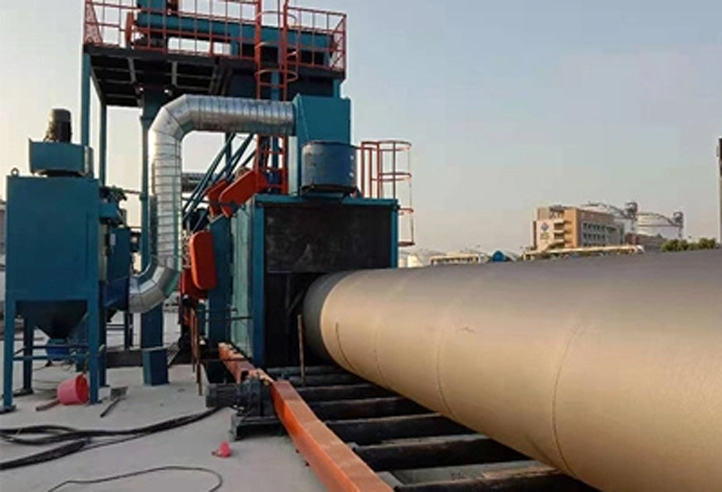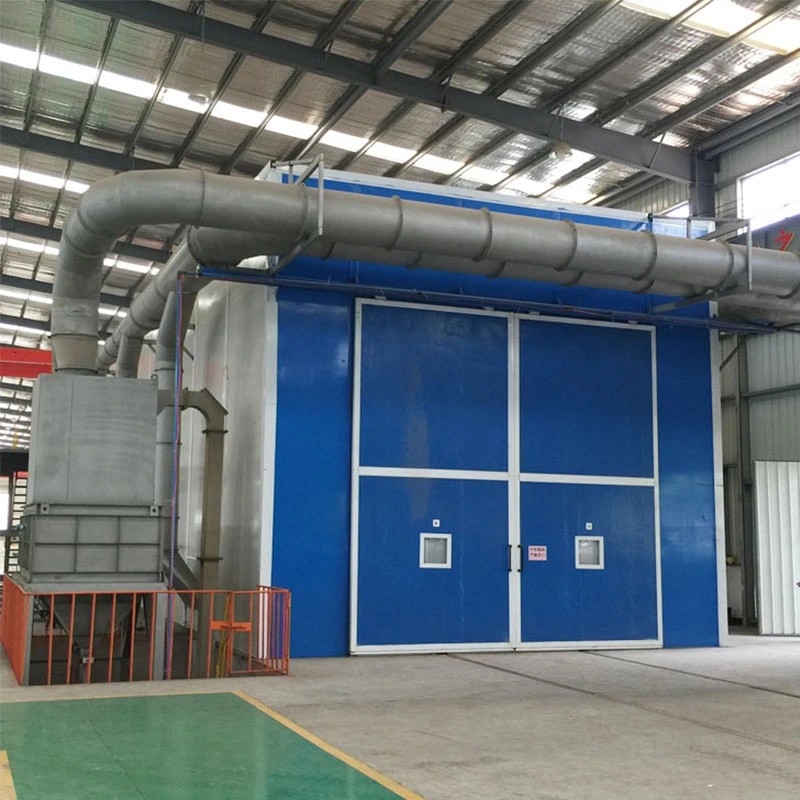A shot blasting machine is a surface treatment technology that uses a shot blaster to propel steel grit or steel shot at high speed onto the surface of a material. Compared to other surface treatment technologies, it is faster, more efficient, and can be used in certain casting processes to retain or stamp parts.
With the development of shot blasting machines, their applications have expanded to various industries, such as removing tire marks at airports, removing old markings on municipal roads, roughening concrete surfaces, cleaning epoxy floors, rust removal on ship decks, and waterproofing bridge surfaces. In these fields, mobile shot blasting machines, often referred to as road surface shot blasting machines, are commonly used. Other extended applications include anti-corrosion and rust removal equipment for oil storage tanks, specialized shot blasting machines for stone surfaces, and large-scale internal and external pipe shot blasting machines. The advent of shot blasting machines has brought convenience to these high-difficulty industries, saving labor and simplifying work processes.

Tumble Belt Shot Blasting Machine: Tumble belt shot blasting machines are suitable for surface rust removal or shot peening of various medium to large batch production workpieces. The workpieces must be collision-resistant and weigh less than 50kg each. These machines can be used standalone or integrated into production lines and fall under the category of foundry machinery.
Working Principle: Workpieces are placed in a rubber belt drum, which moves forward, causing the workpieces to tumble continuously. The shot blaster propels steel shot at high speed uniformly onto the tumbling workpiece surfaces. The steel shot flows through the holes in the belt into a screw conveyor, which transports the shot to a bucket elevator. The elevator lifts the shot to a separator for separation. Dust is extracted by a fan and filtered in a dust collector, with clean air discharged into the atmosphere. Dust on the filter bags is mechanically shaken off into a dust collection box, which can be periodically emptied by the user. Waste sand flows out through a waste pipe and can be reused by the user. The shot-sand mixture is recycled into the machine body, separated by the separator, and clean shot is fed into the shot blaster to treat the workpieces again. Tumble belt shot blasting machines are suitable for cleaning and strengthening small castings, forgings, stamped parts, gears, springs, and other parts, especially those that are collision-sensitive. They are ideal for rust removal and pre-treatment of fasteners.
Hook Type Shot Blasting Machine: Hook type shot blasting machines are standard models with work cylinder diameters ranging from 900 to 1300mm and heights from 1300 to 2200mm. Standard models come with 2-7 blast wheels and can handle loads up to 10,000kg. These machines offer high production efficiency and flexibility, making them ideal for cleaning and strengthening various medium to large castings, forgings, weldments, and heat-treated parts, including fragile and irregularly shaped workpieces.
Working Principle: During operation, after preparatory work (dust removal system, elevator, screw conveyor, etc.), the machine starts working normally. The hook descends to lift the workpiece, rises to a certain position, and then moves along the track into the shot blasting chamber. Upon reaching the predetermined position, it stops and begins to rotate. The shot blasting chamber door is closed, the shot blaster is activated, and the shot supply gate is opened. The workpiece is then shot blasted. This process is repeated until the work is completed, and the machine is shut down in sequence.
Roller Conveyor Shot Blasting Machine: Roller conveyor shot blasting machines offer unparalleled cost-effectiveness and are ideal cleaning equipment. Mechanical rust removal using shot blasting machines has been widely recognized and applied in production. The equipment combination system ensures reliable and economical processes, meeting the required cleanliness of workpieces. The shot blasting system is highly automated, equipped with user-specified loading and unloading units. The entire system can function as standalone equipment or be integrated into a complete rust removal and anti-corrosion treatment production line.
Advantages:
Simple design, suitable for assembly line production.
Improved production continuity.
Short transport distances (no intermediate product storage).
Reduced operating costs due to integration into automated production lines.
Working Principle: The roller conveyor shot blasting machine is easy to operate. Simply load the steel material onto the machine, press the start button, and after a short cycle, the system automatically unloads the treated material, completing the cleaning process and removing all dust and residual shot. The machine can be integrated with other operations such as sawing, drilling, milling, painting, and drying systems to provide a complete processing solution. Adding conveyor chains and cross-transfer systems can further enhance productivity.

Turntable Shot Blasting Machine: Turntable shot blasting machines are mainly suitable for batch production of small to medium-sized workpieces’ surface cleaning. This equipment is ideal for engine connecting rods, gears, diaphragm springs, and is widely used in the casting and automotive manufacturing industries. It features high production efficiency, good sealing, compact structure, easy loading and unloading, and high technical content.
Steel Plate Pre-treatment Line Shot Blasting Machine: This machine is used for cleaning welded structures, H-beams, profiles, grids, and steel plates. The shot blasters are arranged at multiple angles, using advanced high-efficiency shot blasters to project high-speed dense shot streams onto all parts of the raw steel, achieving three-dimensional, all-around cleaning. This removes rust, welding slag, oxide scale, and other contaminants, resulting in a clean surface with a certain roughness, improving the adhesion of paint films to the steel surface, enhancing fatigue strength and corrosion resistance, improving internal quality, and extending service life.
Mesh Belt Shot Blasting Machine: Mesh belt shot blasting machines are used for cleaning disc-shaped, plate-shaped castings, machine bodies, and structural parts. They apply strong shot blasting to the original state of steel and castings to remove rust, welding slag, and oxide scale, achieving a uniform metallic luster and improving the quality and anti-corrosion effect of the steel. These machines are mainly used in the automotive, aerospace, railway, and machinery manufacturing industries. The continuous metal mesh belt shot blasting machine allows parts to rotate continuously and uninterruptedly, receiving multi-directional shot blasting cleaning. The pivoting blast wheels maximize shot blasting efficiency while avoiding part collisions that could damage surfaces.
Internal Cylinder Shot Blasting Machine: This machine uses shot blasting technology to clean the inner walls of cylindrical objects. It is a new type of internal cylinder shot blasting machine that uses compressed air to accelerate the shot, generating kinetic energy to blast the inner walls of steel cylinders. When the cylinder is positioned in the shot chamber, the shot guns automatically extend into each cylinder, moving up and down to complete full-coverage cleaning of the inner walls. It is the preferred type for the gas cylinder industry.
Overhead Rail Shot Blasting Machine: Overhead rail shot blasting machines are suitable for batch processing of small to medium-sized workpieces. The workpieces are transported by an overhead rail, which can operate continuously, step-by-step, or using advanced push-type overhead rail transport. This allows the workpieces to stop at loading/unloading and shot blasting zones, achieving precise loading/unloading and shot blasting processes. The hooks can carry 50-2000kg, offering high production efficiency and reliable operation. These machines are especially effective for cleaning complex surfaces and internal cavities of workpieces such as engine blocks, cylinder heads, and motor housings. They are ideal for the automotive, tractor, diesel engine, motor, and valve industries. Overhead rail shot blasting machines can be classified by the movement of the overhead rail into continuous, step-by-step, and push-type. They can also be classified by the arrangement of the overhead rail into single-track, double-track, and multi-track.
Road Surface Shot Blasting Machine: The working principle of a road surface shot blasting machine is to mechanically propel shot material (steel shot or sand) at high speed and a certain angle onto the work surface. The shot material impacts the work surface, and the machine’s internal dust collector separates the shot material and debris, allowing the shot material to be reused. The machine is equipped with a dust collector to ensure dust-free, pollution-free operation, improving efficiency and protecting the environment.
Replaces conventional cold and hot forming processes for large thin-walled aluminum parts, avoiding residual tensile stress on the surface and achieving beneficial compressive stress.
Induces compressive stress on the surface of parts, enhancing fatigue resistance and tensile stress corrosion resistance.
Corrects distorted thin-walled parts.